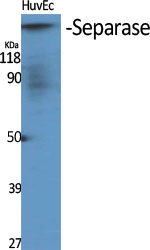Separase Polyclonal Antibody
- Catalog No.:YT4243
- Applications:WB;IHC;IF;ELISA
- Reactivity:Human;Mouse
- Target:
- Separase
- Fields:
- >>Cell cycle;>>Oocyte meiosis;>>Human T-cell leukemia virus 1 infection
- Gene Name:
- ESPL1
- Protein Name:
- Separin
- Human Gene Id:
- 9700
- Human Swiss Prot No:
- Q14674
- Mouse Gene Id:
- 105988
- Mouse Swiss Prot No:
- P60330
- Immunogen:
- The antiserum was produced against synthesized peptide derived from human SEPARASE. AA range:767-816
- Specificity:
- Separase Polyclonal Antibody detects endogenous levels of Separase protein.
- Formulation:
- Liquid in PBS containing 50% glycerol, 0.5% BSA and 0.02% sodium azide.
- Source:
- Polyclonal, Rabbit,IgG
- Dilution:
- WB 1:500 - 1:2000. IHC 1:100 - 1:300. IF 1:200 - 1:1000. ELISA: 1:40000. Not yet tested in other applications.
- Purification:
- The antibody was affinity-purified from rabbit antiserum by affinity-chromatography using epitope-specific immunogen.
- Concentration:
- 1 mg/ml
- Storage Stability:
- -15°C to -25°C/1 year(Do not lower than -25°C)
- Other Name:
- ESPL1;ESP1;KIAA0165;Separin;Caspase-like protein ESPL1;Extra spindle poles-like 1 protein;Separase
- Observed Band(KD):
- 230kD
- Background:
- Stable cohesion between sister chromatids before anaphase and their timely separation during anaphase are critical for chromosome inheritance. In vertebrates, sister chromatid cohesion is released in 2 steps via distinct mechanisms. The first step involves phosphorylation of STAG1 (MIM 604358) or STAG2 (MIM 300826) in the cohesin complex. The second step involves cleavage of the cohesin subunit SCC1 (RAD21; MIM 606462) by ESPL1, or separase, which initiates the final separation of sister chromatids (Sun et al., 2009 [PubMed 19345191]).[supplied by OMIM, Nov 2010],
- Function:
- catalytic activity:All bonds known to be hydrolyzed by this endopeptidase have arginine in P1 and an acidic residue in P4. P6 is often occupied by an acidic residue or by an hydroxy-amino-acid residue, the phosphorylation of which enhances cleavage.,enzyme regulation:Regulated by at least two independent mechanisms. First, it is inactivated via its interaction with securin/PTTG1, which probably covers its active site. The association with PTTG1 is not only inhibitory, since PTTG1 is also required for activating it, the enzyme being inactive in cells in which PTTG1 is absent. PTTG1 degradation at anaphase, liberates it and triggers RAD21 cleavage. Second, phosphorylation at Ser-1126 inactivates it. The complete phosphorylation during mitosis, is removed when cells undergo anaphase. Activation of the enzyme at the metaphase-anaphase transition probably requires the removal of both securin
- Subcellular Location:
- Cytoplasm. Nucleus.
- Expression:
- Bone marrow,Epithelium,
- June 19-2018
- WESTERN IMMUNOBLOTTING PROTOCOL
- June 19-2018
- IMMUNOHISTOCHEMISTRY-PARAFFIN PROTOCOL
- June 19-2018
- IMMUNOFLUORESCENCE PROTOCOL
- September 08-2020
- FLOW-CYTOMEYRT-PROTOCOL
- May 20-2022
- Cell-Based ELISA│解您多样本WB检测之困扰
- July 13-2018
- CELL-BASED-ELISA-PROTOCOL-FOR-ACETYL-PROTEIN
- July 13-2018
- CELL-BASED-ELISA-PROTOCOL-FOR-PHOSPHO-PROTEIN
- July 13-2018
- Antibody-FAQs
- Products Images

- Western Blot analysis of various cells using Separase Polyclonal Antibody diluted at 1:1000
.jpg)
- Western Blot analysis of A431 cells using Separase Polyclonal Antibody diluted at 1:1000

- Immunofluorescence analysis of HUVEC cells, using SEPARASE Antibody. The picture on the right is blocked with the synthesized peptide.

- Immunohistochemistry analysis of paraffin-embedded human colon carcinoma tissue, using SEPARASE Antibody. The picture on the right is blocked with the synthesized peptide.

